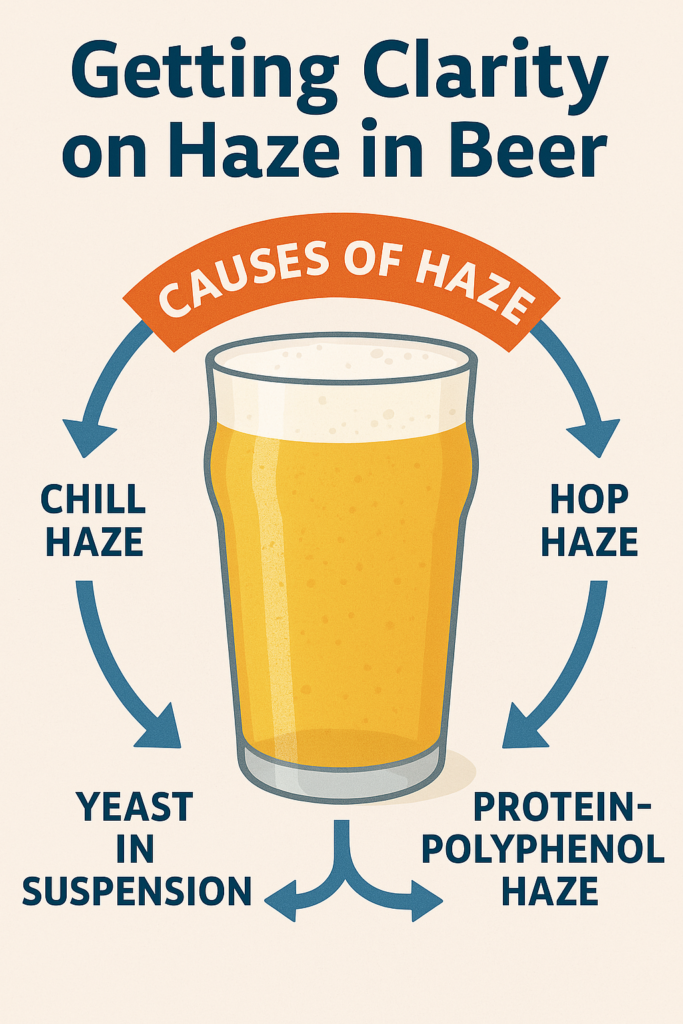BEER CLARITY: WHAT’S CLOUDING YOUR HOMEBREW?
A little beer clarity on haze in beer…
You crack open your latest homebrew, pour it into a pint glass, and hold it up to the light—and it looks like a snow globe. Cloudy with a chance of yeast. Is it a murky mess or something else? Some folks love the look of a hazy brew. Others panic like their batch has just failed a chemistry final. So what gives? Is haze the enemy of good beer, or is it just part of the charm?
Clear beer elevates the visual aspects. Visual appeal is a primary factor in elevating the anticipation of enjoyment. If it looks good, it’s going to taste good. Clear beer is a mark of a quality craftsman with attention to detail.
The truth is, a hazy beer might taste just fine—or it might signal something gone sideways. Whether you’re chasing that crystal-clear West Coast IPA or just curious about why your pale ale looks like murky pond water, understanding beer clarity is the first step to dialing in your brew.

SO WHY IS MY BEER CLOUDY?
Most haze issues reveal themselves after fermentation and the beer is chilling (literally and metaphorically). A cloudy pint can be chalked up to three primary culprits: yeast, proteins, and polyphenols. There is a fourth reason: in more dramatic cases, bacterial infection.
Let’s break them down and get a little clarity here!
1. Yeast That Refuses to Settle Down
Yeast can be like that friend who overstays their welcome. Some strains are courteous and flocculate—meaning they clump up and fall to the bottom when the party’s over. Others just hang around, floating in your beer and photobombing your Instagram shots.
Choosing a high-flocculation yeast strain is a good first step toward better beer clarity. But don’t get married to the idea that high floculation is the only way to go. Even with a lazy strain, you can let it chill! Giving your beer some cold conditioning time in the fridge can encourage those micro-squatters to settle out.
Pro tip: Yeast visibility is a no-go if you’re brewing a kölsch or cream ale. Pick a strain that knows when to leave. If your beer is still cloudy, consider a post-fermentation fining agent like dual-fine or gelatin.
2. Protein and Polyphenol Problems
Picture this: you toss a handful of cooked spaghetti and a sprinkle of glitter into a jar of water. The result? It’s anything but clear. This is similar to what happens in brewing; the proteins derived from grains, along with the polyphenols from hops and the tannins from malt, eagerly bond together, creating a murky haze in your beer.
These particles often show up as chill haze—meaning your beer looks clear at room temperature but goes cloudy when it’s cold. If the haze sticks around at any temperature, you’re dealing with permanent haze.
If you’re into the Hazy New England IPA, the high hopping rates during fermentation means more polyphenols to bond with high-protein grain bills. The perfect recipe for permanent haze.
Commercial breweries spend serious coin trying to prevent this. As a homebrewer, you’ve got a few simpler options:
- Add Irish moss or whirlfloc at the end of the boil
- Get a solid hot break during the boil (vigorous boiling is your friend)
- Rapidly chill your wort for a good cold break
Take a look at your grain bill. Higher-protein malts like 6-row varieties can cause clarity problems. Consider using ingredients like rice or corn, with fewer proteins overall. Alternatively, you can try enzyme additives like Clarity Ferm, which prevents some of the bonding of proteins and polyphenols, protecting against chill haze.
3. When It’s Not Haze—It’s Infection
Not all haze is innocent. Sometimes, it’s your beer’s way of screaming, “Something’s wrong!” Infections caused by wild bacteria can cloud your brew and serve up off-flavors ranging from buttery popcorn to gym sock soup.
Common culprits:
- Lactobacillus: Brings unwanted tartness unless you meant to make a sour
- Pediococcus: butterbombs and thick, ropey textures
- Coliforms: Yep, those bring the aroma of old vegetables and regret
If your beer starts getting hazy after bottling and tastes funky, it might be time to review your cleaning game and retire a few questionable plastic fermenters. Scratches in plastic are a great place for bacteria to hide out and wait for the perfect conditions.
HOW TO IMPROVE BEER CLARITY IN FUTURE BREWS
Alright, so now you know why haze happens. What can you do about it?
Settle the Yeast:
- Cold-crash your fermenter before packaging.
- Use fining agents like gelatin or DualFine.
- Let gravity do its thing—sometimes, a little patience is the best filter.
Tackle Proteins and Polyphenols:
- Try a protein rest if you’re using wheat or other high-protein grains
- Use kettle finings during the boil.
- Practice solid whirlpooling to remove hop debris.
- Keep your boil rolling and your wort chilling fast.
Be a Clean Freak:
- Sanitize everything—like, obsessively
- Don’t reuse scratched plastic gear (bacteria love those micro-homes)
- Watch for odd flavors and haze that worsens over time.
CLOUDY STYLE OR UNINTENDED MISTAKE?
Sometimes, a slight haze is precisely what the style calls for. Hefeweizens, New England IPAs, Belgian wits—all wear haze like a badge of honor. But for most other styles, beer clarity is part of the charm. It signals care, precision, and a bit of brewing finesse.
You don’t have to chase perfection in every pint. But knowing how to clear things up can help you make informed choices—and better beer.
After all, a clear beer lets the drinker see what you’ve brewed… no filter necessary.
Want to know more about achieving clarity in the beer? Swing by Northwest Brewers Supply for tips, gear, and classes that’ll take your brew from cloudy to show-off-worthy.

Ben Holm
Owner of Northwest Brewers Supply
Editor/Author of The Hotbreak Blog
Co-Host & Creator of The Beer Craft, Beer, and Brewing Podcast.
940 S. Spruce Street
Burlington, WA. 98233
Tel. (360)-293-0424
E-Mail: brew@nwbrewers.com

